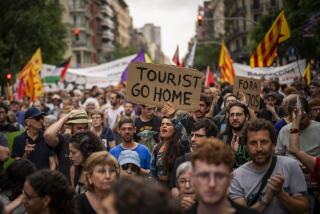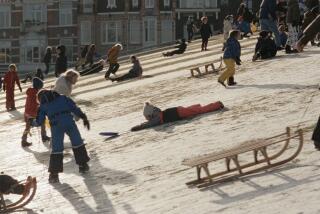Amsterdam, with kids in tow
Amsterdam
When considering Amsterdam, its famous red-light district and the coffee shops where cannabis is smoked, you may assume it’s less than an ideal city to visit with young children. But you would be wrong. On a visit here last summer with Danny, 8, and Fiona, 6, we had a few, um, educational moments. Fiona wanted to know why all the women in the windows looked “like they were getting ready for a party.” (I guess because they were wearing lipstick and underwear and that’s all.) And both kids were shocked, shocked that so many people smoked. (They could not, thank heavens, identify what was being smoked.) But those two issues occupied only 10 seconds of our four days in Amsterdam. (OK, the drunken singing by Italian fans as they celebrated their country’s World Cup victory took up an hour or two, at 3 a.m.)
The rest was fabulous. Amsterdam is precisely the sort of city a child might conjure in her dreams: the concentric circles of canals; the long canal boats with their terraces and little lawns; the overflowing window boxes; the tall houses shoulder to shoulder, their peaked roofs like tricorn hats; the pretty little bridges; the brightly colored doors; and all the bicycles. The Dutch eat pancakes for lunch, put mayonnaise on French fries, have a really big park and what isn’t easily accessible by foot can be quickly reached by really cool trams.
What’s not to like?
We came to Amsterdam as the first leg of a trip through Germany because I had always wanted to visit the Anne Frank House and to see the canals, and this seemed our best chance. Having no sense of the city, we chose to stay in a building right on the Dam, which is the main public square, (which was why the post-Cup drunken rowdies were an issue). Several apartments were available, so we let the kids pick.
They chose the one with the loft bedroom, of course, which was on the top floor. The views were wonderful, but I was pregnant, which meant I was hauling a big belly — and my husband, a backpack — six flights up a circular staircase at least twice a day. In retrospect, I would have chosen one of the quieter neighborhoods, but at least it was easy to find our way home.
We arrived in the afternoon, headed out to the tourist information center a few blocks away to buy tickets for the Anne Frank House and an I Amsterdam Card, and got on a canal boat tour, to get a sense of the city and to fight jet lag.
Amsterdam was even more beautiful than I had imagined, more like a small kingdom than a city, with so much outdoor life, from the cafes to the markets to the boats to the bikes. The tour took us through the Centrum, along the canals that ring the city center. In the warm July sun with the canals glittering under shady green trees, it seemed impossible that anyone would ever want to go indoors.
We spent the rest of the day walking along the central canal belt, from the Herengracht to the Prinsengracht, heading west to the artsy, Greenwich Village-esque Jordaan district, then back east, stopping for lunch at the Pancake Bakery, until we wound up in front of the Anne Frank House.
We had intended to wait a day or so and visit it at night, when the lines would be shorter, and possibly go one adult at a time, but at 5 p.m. on this day, no one was waiting and both kids solemnly said that they really wanted to go too.
We had told Danny and Fiona the story of Anne Frank weeks before our trip; it is not an easy task to try to explain the Holocaust to young children because they keep asking, “Why? Why would people do that?” and of course, there is really no answer. Or no answer you want your children to comprehend. But they understood that a girl and her family had been forced to hide for a long time and that they were finally found and all but one killed because they were Jewish.
We stood in the glimmering dusk of our first day and reminded them that this was a serious, sad place and that they didn’t have to go if they didn’t want to. But they did, and with the understanding that we would take them out if they acted inappropriately, we entered.
There’s no point in writing about how heartbreaking this museum is. The marks on one wall where the Franks measured Anne and her sister Margot’s height brought me immediately to tears, which I think affected my children more than what they were seeing — the tears and the utter weighted silence of the adults around them. When we left, they were subdued for some minutes, contemplating the short lives of children just like them, and we talked about what we had seen off and on during our trip.
The city by bike
With its manageable size and its mixture of history and art and lovely environment, Amsterdam is perfect for the compromises that make family travel successful. So we rented bikes one morning and went riding through Vondelpark, just outside the Centrum (my one regret was that Danny and Fiona weren’t quite old enough to navigate the city proper on bikes) and then visited the Rijksmuseum Amsterdam, which was nearby. Under renovation until 2008, the normally vast national museum was reduced to a perfect family size. (Big hit: the illuminated “tour” of the museum’s most famous work, Rembrandt’s “The Night Watch.” You enter a room in which one wall is the painting and bits are lighted up and explained.)
We took a half-day walking tour — the kids’ favorite part was the bronze statue of “The Night Watch” at Rembrandtplein — and then headed over to the Scheepvaartmuseum (Netherlands Maritime Museum), which included lots of playtime on a very cool ship called De Amsterdam. (This is also currently under renovation, but the nearby Science Center is an excellent alternative.)
We got exemplary behavior from the kids at the Rembrandt House Museum (the artist’s studio fascinated them) in exchange for an hour on a “canal bike” (paddle boats). We spent hours in the Van Gogh Museum in the morning, and then let the kids play all they wanted on a huge red and white statue — “I amsterdam” spelled out in giant letters — in the museum plaza.
A word about I Amsterdam, which is the city’s information portal. The I Amsterdam Card, available for adults and children, allows you on the city’s public transportation and offers free passes on canal tours and discounts at the museums. So, if you are in town for more than a day, it’s a smart investment. Along the way, there were cafe breaks — why is European hot chocolate so much better than American hot chocolate? — and World Cup breaks, and even the occasional downtime in our apartment, where we could look down on the ever-changing personality of the Dam, from a book mart to a music festival to the gathering place of backpackers and tourists and many Dutch pigeons.
We explored Chinatown and the Jordaan district, picked the boats we would live on, wondered at the leaning houses with their pulleys to bring groceries up to the top flats and found a playground where there always seemed to be a kids’ soccer game going on.
We also learned that if you kick the soccer ball your father just bought you into the canal, you might as well kiss it goodbye.
We couldn’t decide whether Amsterdam was prettier in the daytime, with its dappled sidewalks and geranium-laden flower boxes, or at night, when the lights of the houses shone in the water of the canals like submerged fairies. But we never wanted to stop walking, to see what was over that bridge or down that winding street. We could have stayed another week or another month. But then we found out that some good friends were moving to Amsterdam, so now we know we’ll be going back.
More to Read
Sign up for The Wild
We’ll help you find the best places to hike, bike and run, as well as the perfect silent spots for meditation and yoga.
You may occasionally receive promotional content from the Los Angeles Times.







